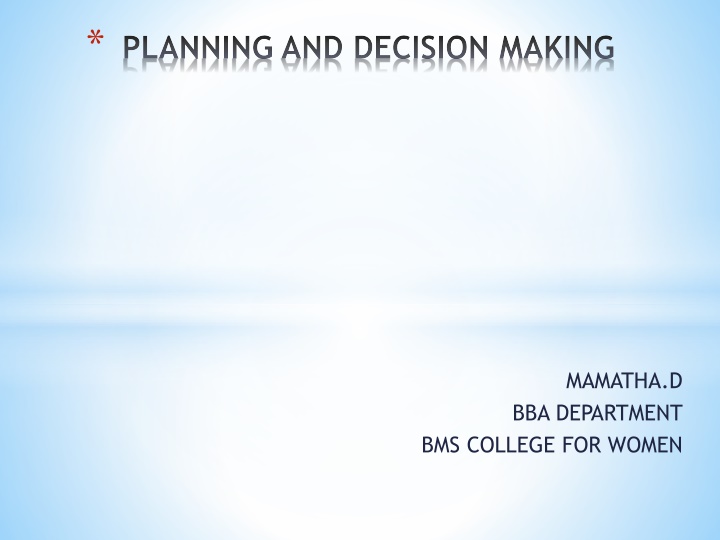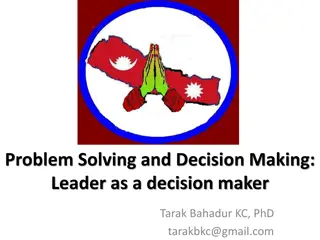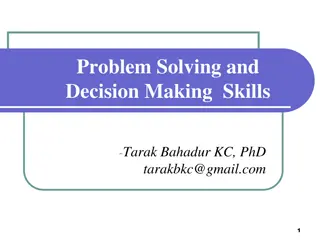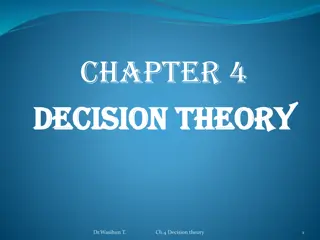Essential Aspects of Planning and Decision Making
Planning and decision-making play vital roles in organizational management. The process involves setting objectives, analyzing information, making informed decisions, and implementing plans to achieve desired outcomes. Essential elements of good planning include clear objectives, flexibility, balance, and coordination among short-term and long-term goals. The importance of planning lies in achieving objectives, reducing risks, enabling resource allocation, and facilitating effective control. The planning process involves awareness of opportunities, analyzing information, setting objectives, and formulating supporting plans.
Download Presentation

Please find below an Image/Link to download the presentation.
The content on the website is provided AS IS for your information and personal use only. It may not be sold, licensed, or shared on other websites without obtaining consent from the author.If you encounter any issues during the download, it is possible that the publisher has removed the file from their server.
You are allowed to download the files provided on this website for personal or commercial use, subject to the condition that they are used lawfully. All files are the property of their respective owners.
The content on the website is provided AS IS for your information and personal use only. It may not be sold, licensed, or shared on other websites without obtaining consent from the author.
E N D
Presentation Transcript
* PLANNING AND DECISION MAKING MAMATHA.D BBA DEPARTMENT BMS COLLEGE FOR WOMEN
* PLANNING AND DECISION MAKING Definition: According to George R. Terry Planning is the selecting and relating of facts and the making and using of assumptions regarding the future in the visualization and formulation of proposed activities believed necessary to achieve desired results According to Koontz and O Donnel Planning is an intellectual process, the conscious determination of courses of action, the basing of decisions on purpose, acts considered estimates . PLANNING IS A PREDETERMINED COURSE OF ACTION TO ACHIEVE A SPECIFIED AIM OR GOAL. IT IS CONCERNED WITH DECIDING IN ADVANCE WHAT IS TO BE DONE, WHEN, WHERE, HOW AND BY WHOM IT IS TO BE DONE.
* NATURE AND CHARACTERISTICS OF PLANNING 1. Focus on objectives 2. It is an intellectual process 3. Planning is a selective process 4. Planning is pervasive 5. Planning is an integrated process 6. Planning is directed towards efficiency 7. Planning is flexible 8. It is a decision-making process 9. It is a continuous process 10.Planning is goal-oriented 11.Planning and Control are inseparable 12.Planning is directed towards efficiency, economy and accuracy
* ESSENTIALS OF GOOD PLAN 1. It should be based on clearly defined objectives. 2. It must be simple and easily understandable. 3. It should be flexible or adaptable. 4. It should be rationale and appropriate. 5. It must be balanced. 6. It should be comprehensive. 7. There should be proper co-ordination among short-term and long- term plans. 8. It should provide standards for the evaluation of performance. 9. It should be practicable and action-oriented. 10.Different plans must be properly integrated and harmonised with one another.
* IMPORTANCE OR ADVANTAGES OF PLANNING 1. Planning helps in achievement of objectives 2. Planning reduces uncertainty and risk 3. Planning enables resource allocation 4. It helps in co-ordination 5. It helps in effective control 6. It facilitates unity of action 7. It helps in avoiding business failures 8. Secures economy in operation 9. Planning provides basis of decentralization 10.Planning provides sense of direction 11.Guides decision-making
* PLANNING PROCESS 1. Awareness of opportunities and problems 2. Collecting and analysing information 3. Determination of objectives 4. Seeking necessary information 5. Establishing the planning premises 6. Identifying and developing alternative course of action 7. Selecting the best course of action or selection of a plan 8. Formulating supporting plans 9. Communication of plans 10.Securing participation of employees 11.Providing follow-up and future evaluation
STANDING PLANS/REPEATED USE PLANS: Standing plans are plans which are used repeatedly (i.e. over and over again) over a long period of time for tackling frequently recurring problems and issues. They give ready-made answers to issues which occur again and again. They make managerial decisions and actions easy and increase managerial efficiency, as they offer standard procedures for tackling similar and frequent recurring problems and issues. Standing plans include: 1. Objectives 2. Policies 3. Procedure 4. Methods 5. Rules 6. Strategies
OBJECTIVES: Objectives or goals are the ends towards which every activity aimed to be achieved. Objectives are the basic plan of the firm department which contribute to attainment for enterprise goals. Objectives have great influence on working of an organization. Definition: According to Dalton Mc. Farland, Objectives are the goals, aims or purpose that organisations wish to achieve over varying periods of times . According to Allen, Objectives are goals established to guide the efforts of the company each of its components . Advantages of Objectives: 1. Objectives provide a basis for all the managerial functions such as planning, organising staffing, directing and co-ordinating. 2. Objectives provide a basis for different types of plans. 3. Objectives help in providing direction to the organisational activities. 4. Objectives enhance the employee satisfaction and morale and motivate to work effectively and efficiently. 5. Objectives provide the sense of unity, harmony and co-operative efforts among people in an organisation. 6. Objectives provide standards which aid in the control of human efforts in the organisation. 7. Objectives act as a sound basis for developing administrative controls. 8. Clearly defined objectives encourage unified planning.
POLICIES: A policy is a general statement which guides thinking, decision making and action in the organisation. These are the standing plan proving guidance to management in the conduct of managerial operation. Policies define boundaries within which decisions can be made and directed towards achievement and objectives. Kinds of Policies: 1. Originated Policies: 2. Appealed Policies: 3. External or imposed Policy: 4. Functional policies: 5. Policies on the basis of levels: PROCEDURE: Procedures are details of action or the guidelines for the achievement of business objectives. Procedures give details of how things are to be done. A procedure is a series of related tasks that make up the chronological sequence and the established way of performing the work to be accomplished. Importance of Procedures: Procedures ensure uniformity of action. They reduce the need for further decision-making by laying down the standard path to be followed. They facilitate co-ordination among the different departments and the personnel in the organisation. They provide a good standard for the manager to appraise to employees.
METHODS: A method describes how one particular step of a procedure is to be performed. A method can be defined as a prescribe manner for performing a given task with adequate consideration to the objectives, facilities available and total expenditure of time, money and effort . RULES: Rule is a set of actions or directions that must be followed by every member of the organisation, so that all human activities are directed towards a common objective. Rules bring discipline in an organisation by guiding people towards an action. STRATEGEIES: A strategy is referred to as the course of action. Strategy is the determination of the purpose and the basic long-term objectives of an organisation and adoption of courses of actions or allocation of resources necessary to achieve these objectives or goals. Strategy can be defined as an executive behaviour whose purpose is to achieve success for the company or personal goals in a competitive environment based on the actual actions of others. Types of Strategies: 1. Master Strategies: 2. Programme Strategies: 3. Sub Strategies/Minor Strategies:
II SINGLE-USE PLANS: These plans are made for handling non-recurring problems. Single-use plans are also referred to specific plans as these are meant to solve a particular problem. These plans are formulated to handle non-repetitive and unique problem. These plans cannot be used again and again. PROGRAMMES: A programme is a sequence of activities designed to implement policies and accomplish objectives. Programmes may be taken as a combination of policies, procedures, rules, budgets; task assignments etc. are developed for the specific purpose of carrying out a particular course of action. Programmes are complexes of goals, policies, procedures, rules, task assignments, steps to be taken, resources to be employed and other elements necessary to carry out a giving course of action. PROJECTS: A project plan may be defined as part of major programme plan with a distinct object that is required to be achieved within the given time frame . A project is a complex of policies, procedures, rules, etc. to carry a given course of action. Thus, a project is prepared in the context of the objectives incorporating policies, procedures, rules and other elements which are for project preparation and execution.
BUDGETS: A budget is a financial or quantitative statement of expected inflows of financial resources, prepared for a definite period of time. The term budgeting is used for preparing budgets and other procedures for planning, co-ordination and control of business enterprise. A budget is a single-use plan of expected results expressed in numerical terms. Need for preparing a Budget: Budgets are required for formulating future policies. They are needed for departments or segments of an enterprise. Budgets act as a tool of control in the hands of management. Budgets fixed for various persons will be the criterion fixed for assessing the performance. Budgets act as motivation for various employees. performance are fixed, then persons will try to achieve them at the earliest. They have been given a goal for which they should work. ensuring co-ordinating among various When targets for
On the basis of level or focus in the organisation: Strategic Planning: Strategic planning are made to achieve overall objectives of the organisation. These plans aim at achieving the strategic goals through effective allocation of resources over different functional areas. These plans are done by the top level managers and relate to a period of 3 to 5 years. Tactical Planning: Tactical plans are the means to support and implement strategic plans. planning is a process of making detailed decisions about what to do, who will do and how to do it. Tactical plans are made by middle manager for their departments and relate to a period of 1 3 years. Tactical plans are more specific and precise and lay-down exactly what is expected of different departments. Operational Planning: Operational plans are the means to support tactical and strategic planning. Operational plans are intended to achieve the operational objectives of an organisation. Operational planning is highly specified and have limited scope in laydown exactly what is expected of different sections of the organisation. These plans are made by the lower-level managers which relate to short period of time, less than one year. Tactical
* DECISION MAKING Importance of Decision-Making: Management is essentially a process of decision-making and managers at various levels are mainly concerned with decision-making. making is the vehicle for carrying managerial work load and discharging managerial responsibilities. It is through decision-making that managers strive to achieve organisational goals. They attempt to bridge the gap between the existing situation and desired situation by taking executing decision. Managers who use a rational, intelligent and systematic approach are more likely to come up with high quality solutions. Decision-making have a clear understanding of alternative course of action to accomplish the goals. Decision-making is based on the information available with the decision makers and their ability to evaluate alternatives. Decision-making aims at deciding the best solution by selecting the alternative for effective management. Thus, every aspect of management organising, staffing, directing, co-ordinating determined by decisions, the result of which is the performance in the organisation. Decision- functions such and as planning, controlling is
PROCESS OR STEPS INVOLVED IN DECISION-MAKING: 1. In making a decision, the manager should follow the following steps in proper sequence. The steps include- 2. Identification of problem 3. Establishment of objectives 4. Search or developing alternative course of action 5. Evaluation of alternatives 6. Selection of the best alternative 7. Implementation of the alternative 8. Monitoring of the effects of implementation 9. Feedback or Follow-up
MANAGEMENT BY OBJECTIVES (MBO) Management By Objectives (MBO) is a process of defining objectives within an organisation so that management and employees agree to the objectives and understand what they are in the organisation. MBO is a technique and philosophy of management based on converting an organisational objective into a personal objective on the presumption that establishing personal objectives makes an employee committed, which leads to a better performance. MBO may be defined as a collaborative goal setting process where after establishing of prime management, departmental managers and unit managers define their own goals within the given perimeter of organisational goals. MBO works from bottom up as well as from top down . goals and strategic by top
MANAGEMENT BY exception (MBE) Management performances. pay attention to only exceptional significant deviations from present standards and should not lose their valuable time and effort in attending to minor, insignificant variations. by According to this concept, managers at each level should Exception involves measurement of current The concept of MBE states that managers should concentrate their efforts only on significant deviations rather than each and every organisational activity. MBE has six basic dimensions such as 1. Measurement 2. Projection 3. Selection 4. Observation 5. Comparison 6. Decision-making ------------
Advantages of MBE: 1. It saves the time of managers because they deal only with exceptional matters. 2. It focuses managerial attention on major problems. 3. It facilitates delegation of authority and increase span of control. 4. It forces managers to review past history and study related business data for identifying deviations. 5. It keeps management alert to opportunities and threats by identifying critical problems. 6. It provides qualitative and quantitative yardsticks for judging situations, people and results. 7. It enhances the degree of communication between different segments of organisation.
QUESTION PAPER QUESTIONS: 2015: What do you mean by Decision making? (2) Explain the importance and steps of Decision-Making.(6) 2016: What is planning?(2) Explain the advantages of planning.(6) What is Decision making? Explain the process of Decision making.(14) 2017: What is decision making?(2) What is planning? Explain the process of planning;(14) 2018: What is decision making?(2) Analyse the essentials of good plan.(6) 2019: Give the meaning of MBO.(2) What is Single use plan?(2) Explain planning process in detail. (15)
Assignment Questions: 2 Marks: Define planning. What are planning premises? State the essentials of a good plan. What is single use plans? What are standing plans? What are objectives? What are policies? What are procedures? Define methods. what is rule? What is budget and strategy? What do you mean by standing and strategic plan? What is decision making? What is MBO? What do you mean by MBE?
5 Marks: Explain the nature of planning. What is planning? Discuss various steps in planning. Explain the advantages and limitations of planning. Explain the importance of decision making. What are the advantages and disadvantages of MBO? Explain the important purpose of management by exception. 15 Marks: Explain the types of plans. Discuss the steps in planning process. What is decision making? Explain the steps involved in decision making. What are advantages and disadvantages of MBO and MBE.























